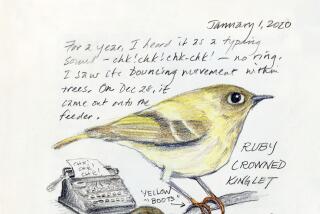When bird watchers get cutthroat
- Share via
The year Sammy Sosa and Mark McGwire were battling each other for the baseball single-season home run record, a competition of a different sort but with the same nail-biting tension was taking place across the continent. Each year on Jan. 1, those in the birding world infected with a spirit of obsessive rivalry embark on “The Big Year,” a race to see who can see the most breeds of birds in North America over the course of 365 days. In 1998, the year limned by Denver journalist Mark Obmascik in his riveting narrative, “The Big Year,” the competition, which dates to 1900, was the toughest ever, with three cutthroat birders wrangling for the lead.
There was Sandy Komito, a street-smart roofing contractor from the Bronx who had set the earlier Big Year record of 721 birds in 1987 and was prepared to spend most of his time and between $8,000 and $12,000 a month to hop last-minute flights to Alaska, Wisconsin, California, Oregon, New Mexico, Texas, British Columbia and wherever else rare birds had reportedly been seen; Al Levantin, a highly successful businessman who regularly took off from his mansion in Aspen, Colo., to track down avian species even though stalking the pelagic varieties over the ocean made him devastatingly seasick; and Greg Miller, a stout software engineer from New Jersey and the only competitor to somehow manage a full-time job during the contest, who maxed out six credit cards and took loans from his dying father to be a genuine contender.
Komito’s plans for the year, as described by Obmascik, were typical of the three: “He expected to be away from home 270 of the next 365 days chasing winged creatures around the continent. There were ptarmigans to trail on the frozen spine of the Continental Divide in Colorado and hummingbirds to hunt in the heat of the Arizona desert. He would prowl the moonlight for owls in the North Woods of Minnesota and wade the beaches of South Florida at dawn for boobies. He planned to race after birds by boat in Nova Scotia, by bicycle in the Aleutian Islands and by helicopter in Nevada. Sleep was not a priority, but when it came, he would be tossing in the army bunks of Alaska and turning on the rolling waves of the Dry Tortugas.”
“The Big Year” combines the best of adventure tales, mystery writing and nature narratives, and even readers who are not birders will soon find themselves cheering the competitors on, bemoaning a wrong turn in the Florida Everglades, braving mountain lions and mosquitoes and slogging through alligator-infested swamps in search of the next bird. At one point, as Miller and Levantin work together in pursuit of an exceptionally difficult-to-find breed, the harrowing nature of their chase dawns on them. “Flying [in] a helicopter in the mountains during a snowstorm to see a Himalayan snowcock ... ,” Obmascik reports, “was not what either man had ever envisioned for his newspaper obituary.” The winning result of that year’s race, 745 species (you’ll have to read the book to find out which man accomplished it), is the most impressive ever. Thanks to the strongest El Nino year on record and a pre-9/11 world in which the birders could easily catch last-minute flights, it is a record, the author tells us, that may never be broken.
Although Obmascik did not witness a single day of the Big Year and bases the book on extensive interviews, his descriptions of birds -- and the humans who stalk them -- are humorous and vivid. He describes the Baird’s sparrow, for example, as sounding “like song sparrows without a rasp, a Lauren Bacall who had never taken up cigarettes.” And of the birds seen on Attu, the westernmost island of the Aleutians, where these extreme birders spend an extended time, he writes that the “same drab brown birds that barely rated a wintertime yawn in Ohio were transformed into brilliant spring eye-catchers in Attu. Lapland longspurs stuck out with a gaudy yellow bill, black mask and rufous cape; snow buntings were a dramatic white-and-black. Alaska was the Honeymoon Hotel for birds, and everyone wore the finest breeding plumage.”
Along the way, Obmascik imparts fascinating information on bird identification, as well as the phenomenon of migration. We learn, for example, that at peak migration, as many as 45 million songbirds arrive in a single night along 300 miles of the Gulf Coast, from Corpus Christi, Texas, to Lake Charles, La. “That’s 150,000 birds per mile, or 15,000 per city block,” he writes.
Bursting with avian statistics, eagle-eyed details as well as the best and worst of the human species’ competitive nature, “The Big Year” is a compelling read for anyone who likes a good, feather-ruffling race. The book, in short, is a lark.


